how to find body fat percentage
If you've been following BuiltLean, you know losing fat WITHOUT losing muscle is the path to get lean.
So how do you track if you are losing fat, or muscle, or both? Aside from weighing yourself weekly and maintaining strength levels as a good barometer, measuring your body fat percentage can be useful.
I have an overview of the 5 most common methods of how to measure body fat percentage below, along with the ONLY method to perfectly measure body fat percentage.
While these 5 methods vary in accuracy, the key to assessing body fat levels is consistent measurements over time (repeatability) so that you can effectively track your progress.
1. Skin Fold Caliper
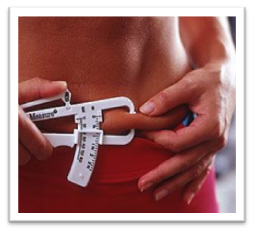
The "skin fold" method measures your body fat percentage by pinching your fat with your fingers then measuring the thickness with a body fat caliper. The reading is given in millimeters, which you compare to a chart with age and gender to arrive at your body fat percentage. There are many different types of caliper tests, which range from only one site like with the Accumeasure Body Fat Caliper to a 7 site Jackson Pollack Method (some are as high as 12 sites).
Upside
- Accurate
- Dependable (when skilled at measuring)
- Repeatable
Downside
- Variability of measurement (same exact spot needs to used each time)
- More than one-site test requires a skilled fitness professional (I've done these thousands of times!)
- For people 35+ pounds overweight, fat may not fit within caliper, so it's less accurate
Bottom Line
Skin Fold is hands down the most effective, accurate, practical method to measure and track your body fat percentage. The self-administered Accumeasure Body Fat Caliper retails for under $10 and is sufficient for most people.
2. Bioelectric Impedance Analysis
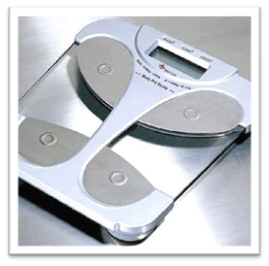
Bioelectric Impedance Analysis, or BIA, determines the electrical impedance, or opposition to the flow of an electric current through the body. Muscle has high water content, and is highly conductive, while fat has lower water content and is not highly conductive. Based on the strength of the impedance along with height and weight metrics, the BIA scale will estimate fat-free body mass and body fat percentage.
Many consumer weight scales like Tanita Body Fat Monitor Scale also come with BIA capabilities, and there are others that require holding the BIA device in your hands. Because the BIA test is based on body water balance, your state of hydration can impact the level of accuracy.
Upside
- Very easy to administer
- Inexpensive (most weight scales around $50 or even less have BIA)
Downside
- Questionable Accuracy
- Variability of results dependent on hydration level
Bottom line
If you can't use calipers, this is a far second option. If you have a high body fat percentage (calipers can't fit around your fat pinch), or you have 35+ pounds to lose, start with BIA, then move to calipers. BIA readings for those with low body fat tend to be completely inaccurate.
3. Anthropometric
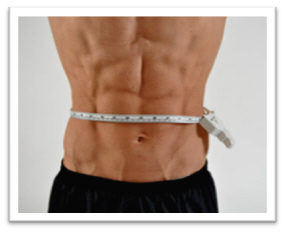
This method uses body circumference measurements to estimate body fat percentages. The U.S. Navy method takes waist, neck, and height circumference for men and hips, neck, and height for women.
A U.S. Navy Method calculator is available on this website where you can input your measurements on right hand column. If you don't have a cloth measuring tape, you can purchase a MyoTape Body Tape Measure, which I'm using to measure my waist in the picture to the right.
Upside
- Easy to Administer
- Cheap
Downside
- Questionable Accuracy (Body fat is not directly measured)
Bottom Line
I would consider this method the least accurate because it doesn't directly measure body fat (or even attempt to). For example, I have around 6% body fat using calipers, but according to anthropometric, my body fat is around 11.5%. If you don't have a BIA scale, or calipers, it can be a decent start.
4. Hydrostatic Weighing
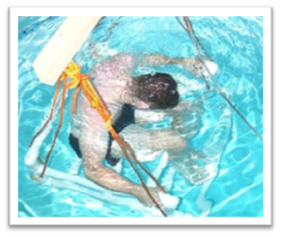
This method is considered the "Gold Standard" (+/- 1.5% error) of body fat measurement that requires being submerged in a specialized tank of water. Because bone and muscle are more dense than water, a person with a larger percentage of fat free mass will weigh more in the water and have a lower percent body fat. Conversely, a large amount of fat mass will make the body lighter in water and have a higher percent body fat.
Accuracy of the reading is contingent upon blowing all the air out of the lungs during pretest screening. The test takes about 20-30 minutes, costs around $100-150, and is available at research labs, universities, or hospitals.
Upside
- Very accurate, considered Gold Standard
Downside
- Impractical
- Expensive
- Not repeatable (unless you liked repeatedly getting dunked in a tank and spending $150)
Bottom Line
If you are extremely curious to get the most accurate measure of your body fat percentage, or you are a bodybuilder, or fitness model tracking your progress, Hydrostatic Weighing may make sense. Otherwise, it's far too impractical.
5. DEXA Scan
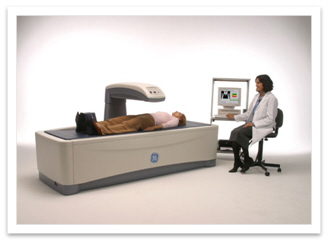
Dual Energy X-ray Absorptiometry known as DEXA is fast becoming the "new" gold standard of body fat measurement because it's based on a three-compartment model that divides the body into total body mineral, fat-free soft (lean) mass, and fat tissue mass. Hydrostatic Weighing on the other hand only uses a 2 compartment model (fat free mass and fat mass).
DEXA also allows for body fat distribution analysis, so you can figure out with precision how fat is distributed in various parts of your body. In the past, DEXA was only used to measure bone mineral density for ostopenia and osteoporosis in older individuals. The procedure uses a body scanner with low dose x-rays, so it's completely safe, and takes about 10-20 minutes.
Upside
- Very accurate
Downside
- Expensive: Around $250
- Not repeatable (unless you don't mind spending $250 every couple weeks)
Bottom Line
Similar to Hydrostatic Weighing, if you are extremely curious to get the most accurate reading of your body fat percentage, or you are a bodybuilder, or fitness model tracking your progress, DEXA may make sense. Otherwise, it's far too impractical and expensive.
All these methods rely on algorithms to convert a measured parameter into an estimate of body fat percentage, so none of them are perfect. Algorithms have variation based on how the underlying assumptions and formulas apply to different populations.
So what's the only way to measure body fat with perfect accuracy? Well, cutting open a body and examining the fat, like with a cadaver. Seriously, that's really the only way to measure body fat percentage most accurately.
I plan on digging deeper into each method in future articles, but I hope this was a helpful overview of each method.
how to find body fat percentage
Source: https://www.builtlean.com/5-ways-to-measure-body-fat-percentage/
Posted by: mcnewnont1962.blogspot.com

0 Response to "how to find body fat percentage"
Post a Comment